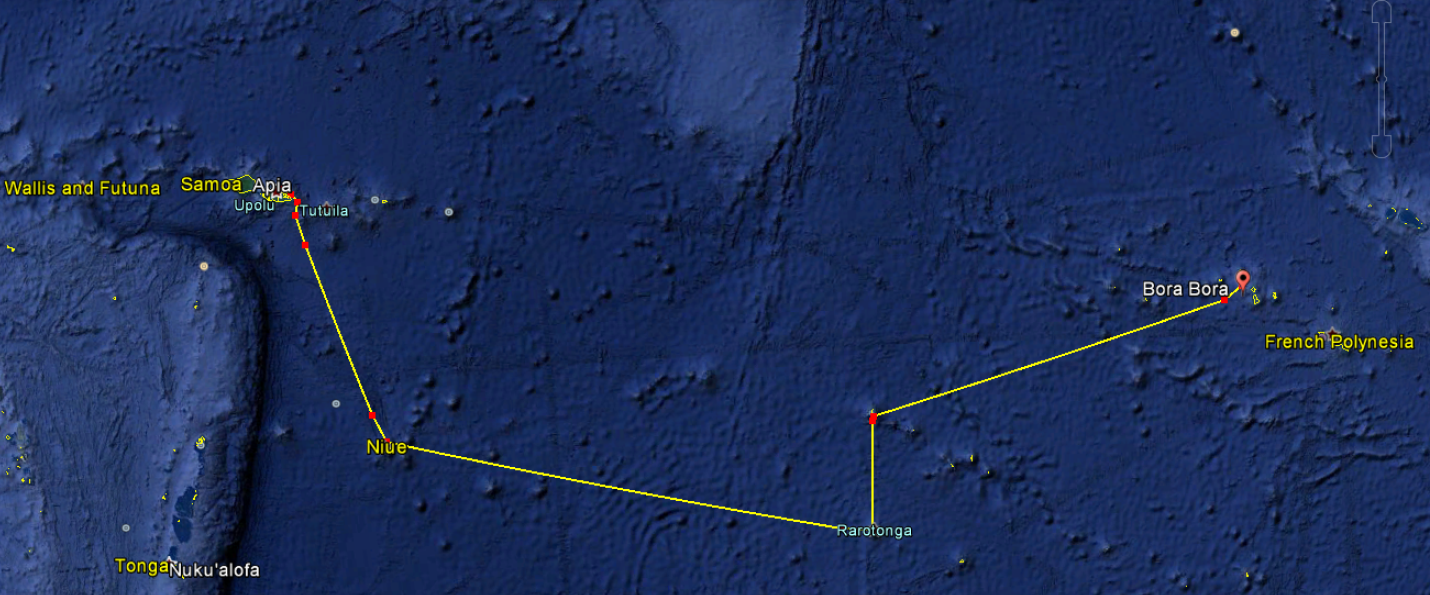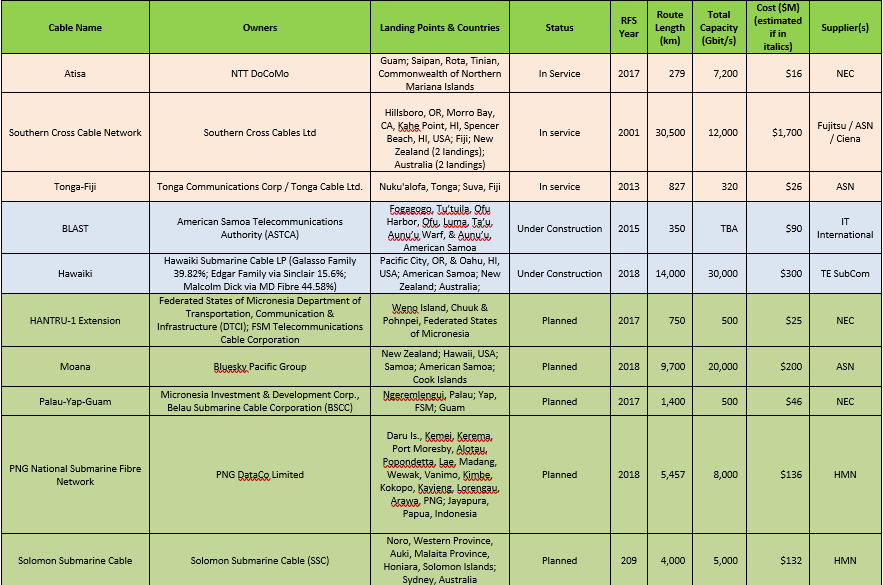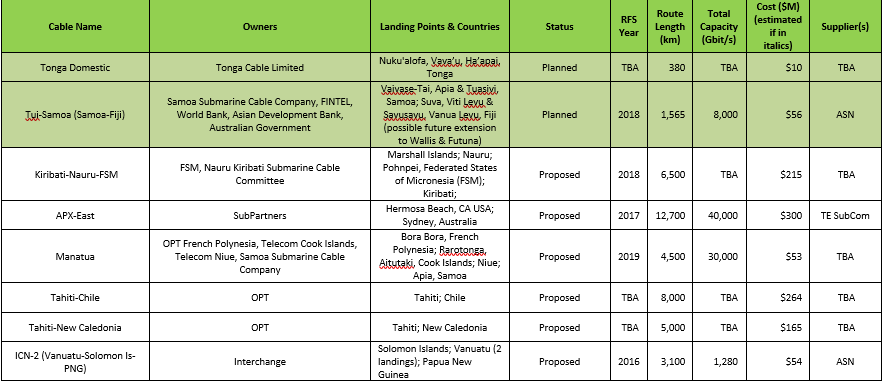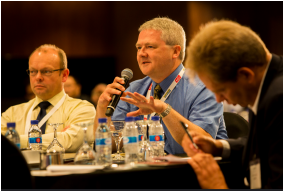|
The announcement by visiting New Zealand Prime Minister, Bill English, that New Zealand is committing A$15 million (US$11.4M) of funding towards the Manatua submarine cable between Samoa and French Polynesia, is welcome news for internet users on Rarotonga and Aitutaki. Estimated Route of “Manatua” Cable Source: Julian Rawle Consulting At a press conference with Cook Islands Prime Minister, Henry Puna, English said the cable system would link the two islands to faster, low-cost, internet, which he said was essential for economic and social development. The project will extend the existing Honatua subsea cable in the Pacific to Samoa, Niue and the Cook Islands, hopefully bringing us faster, more affordable and reliable internet services. The Manatua cable main trunk will run between Apia and French Polynesia with branching units to Niue, Rarotonga, Aitutaki and Borabora. A consortium made up of the participating countries will construct, manage and own the cable. The bidding documents are almost completed and the consortium will be going to market within the next few weeks. While no precise dates are available, it is hoped the cable will be ready in 2019, says Manatua Cable Cook Islands Focal Point, Elizabeth Wright-Koteka, who leads the Manatua Cable Cook Islands team. “The consortium partners will share the costs. The actual price will of course be determined during the procurement process. “However, the cost estimated for the Cook Islands is around A$34.4 million (US$26M). New Zealand is providing A$15 million towards the Cook Islands costs and the remainder of the costs for the Cook Islands will be from the ADB.” Wright-Koteka says the cable project is being led by the Office of the Prime Minister’s ICT division, in close collaboration with Mark Brown as Telecommunications minister. “I have been engaged as the focal point for the project and I, along with Pua Hunter, sit on the Project Steering Group,” said Koteka-Wright. “We have also engaged technical support through ADB of a submarine cable technical specialist and also a specialist telecommunications legal adviser. “These two gentlemen provide technical backstopping as we do not have the specialized skills in this area available on island. Their advice includes optimal configuration, specifications, drafting the required documentation, etc. needed to progress this work. “In addition, other members of the Manatua Consortium also have specialized technicians working together with us. The consortium has also engaged collectively a company called AXIOM to assist in the preparation work as well.” “We hope that procurement will be completed by October and the construction process will commence thereafter.” The Manatua cable will have three pairs of fibers, operating at 30 Tbit/s. New Zealand foreign minister, Murray McCully, agreed to the extension at a meeting in Auckland in March with Cook Islands Prime Minister, Henry Puna, the Prime Minister of Samoa, Tu’ilaepa Sa’ilele Malielegaoi, and French Polynesia President, Edouard Fritch. The Polynesian version of France TV Info later reported the cable would be 4,500km long and would interconnect with the Honatua cable to provide broadband internet services. Tahiti Infos put the cost of the project at the equivalent of A$53 million (US$40M) in a report that also said it would be co-financed by New Zealand and French Polynesia. The project, also known as the Manatua Polynesian Connectivity Project cable system, was also discussed at a breakout session for governments at the 21st Pacific Telecommunications Association (PITA) annual general meeting in Rarotonga earlier this year. The final signing process for the Manatua cable agreement between the government of the French Republic on behalf of French Polynesia and the governments of Niue, Samoa and the Cook Islands, coincided with the PITA 21st AGM and Tradeshow. At the time, Puna said the signing was a significant demonstration of trust and cooperation between “our Polynesian brothers and sisters” to improve telecommunications and connectivity among the Cook Islands and the rest of the world. “I believe extraordinary opportunities lie ahead. Information and Communication Technology (ICT), and in particular broadband networks, offer perhaps the greatest opportunity we have ever had to make rapid and profound advances in Pacific economic and social development.” Meanwhile, with planning for the cable well and truly underway, Wright-Koteka, who is contracted by ADB, says all the other countries involved in the cable project countries have set up similar project teams to the Cook Islands one. “We meet on a weekly basis and more if needed via teleconferencing.” Source: www.cookislandsnews.com ANALYSIS: After many years when it was considered impossible to make the business case for connecting Pacific island communities via submarine fiber optic cables, the development of a “Pacific Basin network” now continues apace. As shown below, 1,100 km of submarine fiber optic cable has already been installed for projects specifically designed to provide the islands with connectivity and another 350 km is currently under construction. These numbers pale in comparison with the 13,500 km of “Planned” (having a reasonable chance of coming to fruition) systems. Another 27,000 km is “Proposed”. 7.5 Tbit/s of design capacity has already been added at a cost of US$42M, with an additional 22 Tbit/s planned at an estimated investment of US$600M. The main suppliers in this market are Nokia ASN (4 projects at all stages for US$337M) and NEC (3 projects for US$87M). Huawei Marine (HMN) is now entering the market with 2 planned projects worth US$268M. TE SubCom has clearly made a decision to stay out of this market, preferring to concentrate on winning the large transoceanic systems. Pacific Rim Cable Projects Source: Julian Rawle Consulting
0 Comments
Leave a Reply. |
Julian Rawle, AuthorThought leadership articles and commentary on developments related to the subsea fibre optic cable industry can be found here. Archives
February 2018
Categories |






 RSS Feed
RSS Feed